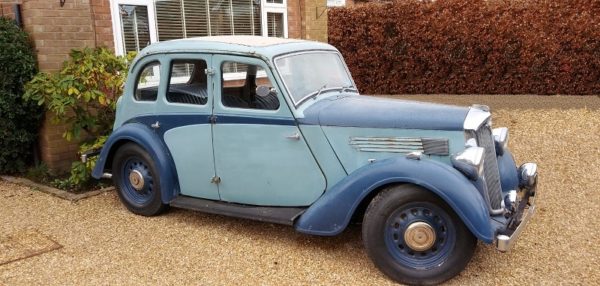
This small car is rarer than we might think. The Wolseley Series II range was launched at the 1935 Motor Sow with the Super Six 16hp, 21hp and 25hp models. The 10/40, 12/48 and 14/56 models followed at the 1936 show, and 1937 brought the final Series II model: the 18/80. The Series II was short-lived; the first Series III appeared in 1937 and the last Series II models went out of production in 1938.
The 12/48 was a larger version of the 10/40 with a greater length and a more streamlined boot at the rear of the car. Around 6,400 were produced. Unlike its Morris equivalent, the 12/48 had an overhead-valve engine, four-speed gearbox and pressed-steel ‘Easiclean’ wheels.
The Series II in our Snapshot can be distinguished from the 1937 Series III by the four horizontal bonnet louvres; the Series III had only three.
These cars looked very similar to the contemporary Morris Series II models, but the bodies were quite different, and some Wolseleys were also given three-tone colour schemes.
The decline of Wolseley as an independent company and its eventual takeover by Morris may have started as early as 1919 when they took over the Ward End, Birmingham munitions factory from Vickers in 1919 and purchased a site for a new showroom and offices in London’s Piccadilly. They spent over £250,000 on the magnificent Wolseley House – more than double their profits for 1919. Lucrative wartime government contracts ended, and the government brought in a special tax on “excess wartime profits”. There was then a moulders’ strike from December 1919 to April 1920 and a sharp general trade slump that peaked in July 1920. Wolseley posted a loss of £83,000 in that year – and the losses climbed thereafter, to £364,000 in 1924.
At the end of October 1926, the company went bankrupt to the tune of £2 million; it was described as “one of the most spectacular failures in the early history of the motor industry”. Wolseley were auctioned by the receivers in February 1927 and purchased by William Morris for £730,000 using his own money. Morris transferred his personal ownership of Wolseley to Morris Motors Limited as of 1 July 1935 and shortly after this all Wolseley models became badge-engineered Morris designs.
But this did not stop Wolseley cars being effective upmarket versions of their Morris stablemates. The car in our Snapshot was seen recently sitting on a suburban drive and, despite its less than immaculate condition, it made an immediately positive impression. We are very pleased to see that it has survived.







The 10/40 and 12/48 were launched in April 1936 followed by the 14/56 in June. The 10/40 and 12/48 were identical except for the diameter of the cylinder bore. It was the 14/56 which was longer in chassis and body, with a six-cylinder engine. There are loads other differences on the Series III 12 such as shape of wings, rear hinged rear doors, monotone colour schemes etc.